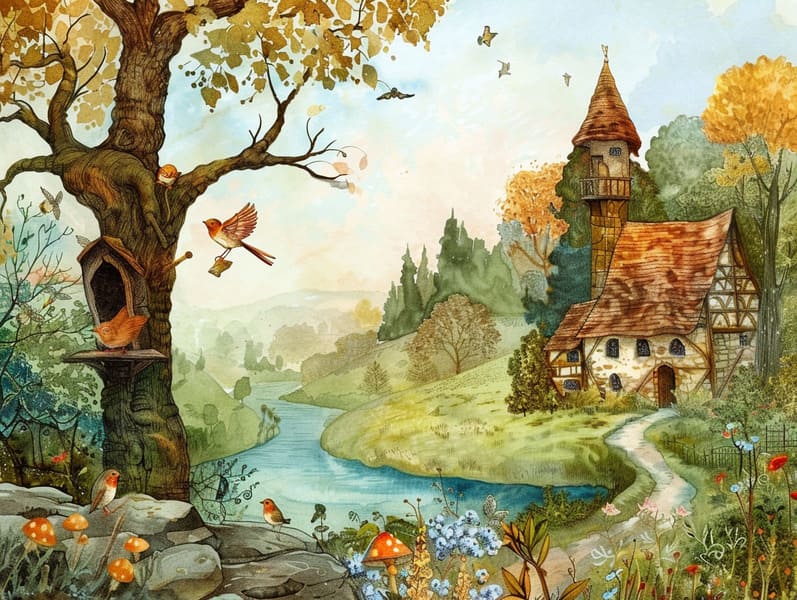
Short fairy tales have legendary status. These tales have been shared from one generation to the next centuries before they were ever inscribed. They were born from a variety of backgrounds, including Middle Eastern traditions. They were initially disseminated among elders, often carrying themes and messages related to the societal norms and beliefs of the time.
The famous Grimm duo, the two Grimm brothers, were among the first to gather many of these beloved stories. Their volume, "Grimm's Story Collection," included classics like "The Little Glass Slipper," "Hansel and Grethel," and "Snow-White and Rose-Red," which have since become staples in the world of classic fairy tales. Similarly, Hans Andersen's delightful stories, such as "The Mermaid," and "The Little Duckling," have captivated hearts worldwide, establishing their place in the pantheon of treasured fairy tales.
Despite their historical roots, classic fairy tales remain as meaningful as ever, especially as nighttime stories for kids. These enchanting tales are now available in multiple formats, including colorful picture books, enchanting animations, and online storybooks.
Their continued relevance can be attributed to several magical reasons:
Ethical Lessons: Ancient fairy tales often whisper important moral lessons. Stories like "The Story of the Boy Who Cried Wolf" teach the benefit of honesty, while "The Story of the Tortoise and the Hare" underline the values of steadfastness and unassuming nature. These stories offer young ones clear distinctions between right and wrong, helping to shape their moral compass in a tender yet lasting way.
Warmth and Understanding: Old fairy tales frequently present heroines facing difficulties and adversities, urging readers to resonate with their struggles and boost their triumphs. For instance, "The Story of Beauty and the Beast" demonstrates the necessity of appreciating inner worth to understand the inner self of a soul, nurturing tenderness and insight.
Cultural Insights: Many fairy tales are infused with the cultural contexts from which they sprang. Exploring these stories can provide fascinating glimpses into different societies, fostering a sense of world appreciation and comprehension.
Fantasy and Imagination: The whimsical elements in traditional fairy tales—spells and potions—encourage children’s fantasies. These stories transport readers to supernatural realms, engendering creative dreams and a sense of astonishment that endures a lifetime.
Classic fairy tales are not only magical but also enlightening. They work as enchanted tools in developing various mind and heart abilities in the young. When traditional fairy tales are voiced, they boost communication skills by teaching new word meanings and sophisticated sentence structures. This practice also advances auditory skills and mental focus, as young readers follow the story, excited to see what happens next.
Furthermore, deliberating the themes and characters of old fairy tales can sharpen thought processes and logical thinking. Little ones learn to discern patterns, expect results, and catch on to cause and effect. These contemplations also further children verbalize their thoughts and feelings, contributing to their emotional intelligence.
In today’s digital age, the prevalence of digital fairy tales has made these fairy tales more obtainable than ever. Web platforms and digital apps provide extensive collections of traditional fairy tales that can be accessed or listened to anytime, anywhere. Fairy tales narrated are particularly prevalent, presenting an enjoyable way for kids to appreciate these delightful tales. Voice books and read-aloud videos carry characters and settings to life, often augmented by bewitching harmonies and tunes that boost the storytelling journey.
The unending appeal of old fairy tales lies in their ability to modify to current times while retaining their core values. Contemporary retellings of these narratives often spotlight more diverse protagonists and modern settings, making them accessible to today’s audience. However, the core values of heroism, charity, and fair-mindedness remain unchanged, continuing to influence young listeners of all ages.
Classic fairy tales also offer a sense of security and knowability. They give a methodical narrative with a clear beginning, middle, and end, often concluding with the settlement of conflicts and the triumph of morality over immorality. This uniformity can be consoling for little ones, delivering a sense of steadiness in an fluid world.
Timeless fairy tales continue to fascinate and educate new generations, maintaining their radiance and pertinence in modern society. As bedtime stories for kids, they confer a perfect blend of delight and instruction, nurturing moral values, empathy, and creativity. The availability of digital fairy tales and the likability of fairy tales spoken make sure that these traditional tales remain acquirable to new generations.
By guarding and recounting these stories, we continue to acknowledge the rich tapestry of storytelling and cultural heritage. Whether you are reading a beautifully illustrated book, delving into a online collection, or hearing an audiobook, the enchantment of traditional fairy tales is always within reach. These stories reveal of find it here the invariable spell of stories and its ability to unite us across generations and cultures.
Whether you are delving into a beautifully illustrated book, discovering a electronic library, or listening on an voice book, the elegance of famous fairy tales is always within reach.
These narratives remind us of the continued presence of tales and its ability to bring us together across generations and cultures, forming a connection that delights and instructs alike.
Comments on “The Inception of Timeless Fairy Tales with Its Persistent Elegance.”